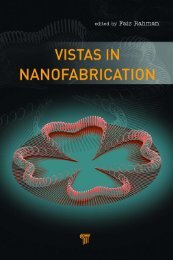Download PDF - Pan Stanford Publishing
Download PDF - Pan Stanford Publishing
Download PDF - Pan Stanford Publishing
You also want an ePaper? Increase the reach of your titles
YUMPU automatically turns print PDFs into web optimized ePapers that Google loves.
Published by<strong>Pan</strong> <strong>Stanford</strong> <strong>Publishing</strong> Pte. Ltd.Penthouse Level, Suntec Tower 38 Temasek BoulevardSingapore 038988Email: editorial@panstanford.comWeb: www.panstanford.comBritish Library Cataloguing-in-Publication DataA catalogue record for this book is available from the British Library.Consumers and Nanotechnology: Deliberative Processesand MethodologiesCopyright © 2013 by <strong>Pan</strong> <strong>Stanford</strong> <strong>Publishing</strong> Pte. Ltd.All rights reserved. This book, or parts thereof, may not be reproduced in any formor by any means, electronic or mechanical, including photocopying, recordingor any information storage and retrieval system now known or to be invented,without written permission from the publisher.For photocopying of material in this volume, please pay a copying fee throughthe Copyright Clearance Center, Inc., 222 Rosewood Drive, Danvers, MA 01923,USA. In this case permission to photocopy is not required from the publisher.ISBN 978-981-4316-16-3 (Hardcover)ISBN 978-981-4364-34-8 (eBook)Printed in the USA
ContentsixPart IVAn Aspect of a More Democratic Science:The Future of Deliberative Processes onNanotechnology and Other EmergingTechnologies 21313. Conclusions: Towards a Third Generation ofDeliberative Processes 21513.1 Introduction 21513.2 The Generational Perspective 21613.2.1 The First Generation of DeliberativeProcesses on Nanotechnology 21713.2.2 The Second Generation of DeliberativeProcesses on Nanotechnology 22113.3 Conclusions on Deliberative Processes onNanotechnology 22513.4 The Future of Deliberative Processes 22713.4.1 Unfulfilled Expectations? 22813.4.2 A Threat to Numerical Democracy? 22913.4.3 An Answer to This Critique 23113.5 Relevant Topics for Deliberation 23413.6 Summarising Appraisal 240Authors’ Biographies 243Index 247
PrefaceThe material for this book is based mainly on results from theEuropean Union’s 7th Framework Program, Science in Societyproject Nanoplat: Development of a Platform for DeliberativeProcesses on Nanotechnology in the European Consumer Market.Most chapters started their life as project deliverables forNanoplat, but they have been expanded, re-written, and re-edited,for this book. The concluding chapter, however, to a large extentbuilds on a project financed by the Norwegian Research Councilcalled Deliberative Processes — Increased Citizenship or a Threat toDemocracy? A Synthesis of Recent Research Within Nanotechnology.The Nanoplat project was coordinated by the National Institutefor Consumer Research, SIFO, in Oslo, Norway. The other partnerswere Institut für Ökologische Wirtschaftsforschung, IÖW, Berlin,Germany, the Central European University, CEU, Budapest, Hungary,the Sabanci University, Istanbul, Turkey, Manchester University,Manchester, UK, the Centre for the Study of Science and theHumanities, the University of Bergen, Bergen, Norway, and theStrategic Design Solutions, SDS, Brussels, Belgium.All authors were involved in the Nanoplat project, and at the timethey were all affiliated with one of these partners, except for FernWickson’s co-authors Michael D. Cobb and Patrick Hamlett (Chapter9).The Deliberative Processes project included SIFO and IÖW aspartners.Editing, post-production, and development of additional text andmaterial was financed by SIFO’s programme for the Study of MaterialCulture; a nice reminder that no matter how small nanoparticlesare, they are still material objects. In the last weeks of assembling,editing, changing templates, checking references, etc., we have beenheavily dependent on the work of Nina Heidenstrøm, SIFO. Thanks.Pål Strandbakken, Gerd Scholl, and Eivind StøOslo & Berlin, Spring 2012
xivOutline of the Bookanalysis. Initially, more than 60 processes were collected, in Europeand abroad (abroad mainly meaning the United States). Further, thechapter maps the ‘intensity’ of the deliberation in a figure using thenumber of participants and the length of the process as variables.In Part II, Citizen-Oriented Deliberative Processes, we, asthe title suggests, review and analyse seven different deliberations,all aiming at involving the common man, the non-expert. The firstchapter, written by Eivind Stø, deals with what has been regardedas the first deliberative process on nano ever, the Citizens’ NanoConference in Denmark (Chapter 3), arranged in June 2004. This haslater come to be known as the ‘Danish model’ and as a ‘consensusconference’. This small, one-evening conference with 29 participantshas had an amazing impact on both nano deliberations elsewhereand actually on Danish science policy as well.Eivind Stø has also written the account of The NanoJury in theUK (Chapter 4); a deliberation with fewer participants (only 16)than the Danish conference, but with more time resources, since itlasted for five weeks. Here the jury concept actually implies a breakwith the idea of a consensus conference. In the jury, disagreement issolved by majority voting.The third process is the Consumer Conference on Nanotechnologyin Food, Cosmetics and Textiles, Germany (Chapter 5). The chapteris written by Gerd Scholl. The number of participants is still rathersmall, 16 again, but here the whole process was longer, lasting up to10−11 months, the actual deliberation with participants going on forfive to six. The panel had good access to experts as well. One notablefeature in addition is that the focus on consumption, even on threespecific areas of consumption, made this conference less generalthan most other deliberations. It addressed specific consumer topics,rather than dealing with science and society in the abstract.With the French Conference Cycle on Nanotechnology, Nanomonde(Chapter 6), we meet a different type of deliberation. GiampieroPitisci’s chapter deals with a cycle of six — one per month for sixmonths — large conferences, with as many as 100 to 120 citizenparticipants. The Nanomonde cycle was arranged by an NGOcalled Vivagora, as ‘vigilance on democracy’ activity and aimed atrepresenting the public voice, facilitating an open dialogue betweenpublic and experts.The second French deliberation included here, and the last ofthe European citizen-oriented processes, is the Citizens’ Conference,
Outline of the BookxvÎle-de-France (Chapter 7); chapter written by Pål Strandbakken.This event is interesting for a number of reasons; it had quite largeresources, administratively, expert wise, and duration wise, andit is well documented through a DVD, but it is mainly interestinghere because of its close ties to politics and decision-making. It wasexplicitly arranged to produce input for the science policy decisionmakingin the Île-de-France region.The Policy Recommendations from the Citizens’ Conference isprinted as Appendix 1, after the chapter.The chapter on Nanotechnology Citizens’ Conference in Madison,USA (Chapter 8) is written by M. Attila Öner and Özcan Saritas. Thiswas a small, university-based consensus conference, modelled on thecitizens’ nano conference in Denmark, in a different political culture,but with more time at hand. The Madison conference is described assomething like an ‘ideal deliberation’, but it suffers from an apparentlack of political impact.The Written Submission from the Citizens’ Coalition onNanotechnology is printed as Appendix 2, after the chapter.The final and probably best-documented citizen deliberation isThe U.S. National Citizens’ Technology Forum on Human Enhancement:An Experiment in Deliberation Across a Nation (Chapter 9), written byFern Wickson, Michael D. Cobb, and Patrick Hamlett. It is interestingin itself, because of the original use of both face-to-face and onlinedeliberations, and it covered a large geographic area. Design wise, theNational Citizens’ Technology Forum (NCTF) process is interestingbecause participants were asked to fill in questionnaires beforeand after the event. Two of the authors (Cobb and Hamlett) werepartners in the initiative and evaluated the original process.The list of facilitators in the six state teams is printed as Appendix3.Part III, Stakeholder-Oriented Deliberative Processes,consists of three chapters. The first is Experiments with Cross-National Deliberative Processes Within FP6 and FP7 of the EuropeanUnion: The Convergence Seminars, the DEMOCS Card Games, and theNanologue Project (Chapter 10), by Eniko Demeny, Judith Sandor,and Peter Kakuk. The title pretty much sums it up. The threeexperiments all clearly go beyond the citizen-oriented processes,involving experts and stakeholders. In addition, all three could belabelled as deliberative processes within research processes.
xviOutline of the BookThe second chapter Standardisation as a Form of Deliberation(Chapter 11) is written by Harald Throne-Holst and PålStrandbakken. In it, the authors account for the rules, methods, andideas/ambitions that drive the standardisation work on nano in theEuropean standardisation body, Comité Européen de Normalisation(CEN), and in the International Organization for Standardization(ISO). The chapter does not analyse a specific deliberative processbut rather aims at analysing the conditions for deliberation in nanostandardisation processes in general.In the third chapter, An Online Platform for Future DeliberativeProcesses (Chapter 12), Francois Jegou and Pål Strandbakken accountfor the development and test runs of Nanoplat’s deliberation tool. Itwas designed as a social computing like tool consensus conferencesamong stakeholders.Part IV, An Aspect of a More Democratic Science: TheFuture of Deliberative Processes on Nanotechnology and OtherEmerging Technologies, has only one chapter, Conclusions: Towardsa Third Generation of Deliberative Processes (Chapter 13), writtenby the editors Eivind Stø, Gerd Scholl, and Pål Strandbakken. In it,they elaborate on the idea of different ‘generations’ of deliberativeprocesses, describing and even prescribing a development towardsmore specific themes and questions as well as arguing for moreclear linkages between what is happening in the exercises and whatshould subsequently happen at the political level. What have welearned from this work and how should the learning be implementedin future deliberations on science and technology?
















